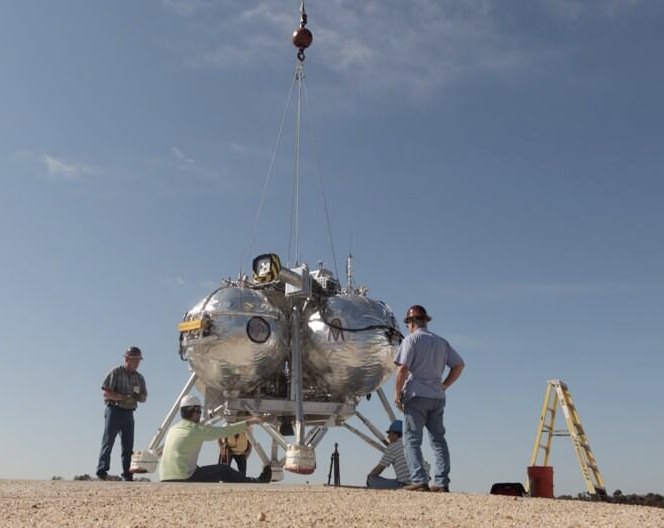)
NASA’s Project Morpheus nailed it again today with yet another successful free flight of their prototype lander, soaring higher, faster, and farther than ever before! Go Morpheus!
The FF9 test, which occurred at 3:41 p.m. EDT at Kennedy Space Center, saw the 2,300-lb (1000-kg) Morpheus craft rise to a height of 580 feet (177 meters) and travel 837 feet (255 m) downrange at 30 mph (48 km/h). After the 85-second flight the craft set down almost exactly on target — only about a foot (.3 m) off.
During today’s test flight the oxygen-and-methane-propelled Morpheus could have cleared the Washington Monument.
The next step is to integrate the Autonomous Landing and Hazard Avoidance Technology (ALHAT) sensors, which allow the craft to identify dangerous terrain and determine the best route to a safe landing — all by itself. This capability will be invaluable for future landings on unexplored surfaces on the Moon and Mars.
“It’s never been done,” said Dr. Jon Olansen, project manager of the Morpheus Project, in 2012. “We’ve never landed of the moon or Mars with real-time hazard detection and avoidance. Most of the Mars missions use air bags. They go where they go, they roll them and they stop… whatever comes, comes.”
Check out the latest incredible free flight video above, and learn more about Project Morpheus here.
Source: NASA
UPDATE: Here’s the “official” NASA video of FF9, showing some fantastic camera views from the craft itself:
)


Looks like something out of the Kerbal Space Program. Very cool. Any idea when it might go to the moon or Mars?
Nice! It’s great to see MORPHEUS back ‘on track’ and moving forward, literally! What fries my potato’s though, is how HOT the exhaust gases are and how that might create problems for landing in areas where ices exist just below the surface of Mars, an asteroid or a comet?
Imagine a Mars lander using this tech coming in for a landing and the exhaust jet creates a mixture of dust and steam, temporarily blinding the landers instruments and depositing a layer of mud on it’s instrumentation.
Hence the skycrane which was used to deposit the Curiosity rover on Mars, without blowing lots of dust all over it. My understanding is that Morpheus is a development testbed that’s not actually going to fly to Mars or anywhere else. It’s powerful enough to fly in Earth’s gravity, so would be total overkill for the Moon or Mars. Most asteroids have so little gravity that you can land on them with maneuvering thrusters.
From the project homepage: “NASA’s strategic goal of extending human presence across the solar system requires an integrated architecture. Such architecture would include advanced, robust space vehicles for a variety of lunar, asteroid, and planetary missions; automated hazard detection and avoidance technologies to reduce risks to crews, landers, and precursor robotic payloads; and in situ resource utilization to support crews during extended stays on extraterrestrial surfaces and to provide for their safe return to Earth. NASA’s Advanced Exploration Systems (AES) portfolio includes several fast-paced projects that are developing these necessary capabilities. Specifically, the Morpheus project and the Autonomous Landing and Hazard Avoidance Technology (ALHAT) project provide technological foundations for key components of the greater exploration architecture necessary to move humans beyond low Earth orbit (LEO).”
Not that MORPHEUS couldn’t be used at Mars.. the liquid methane/oxygen fuel might possibly be made in situ? Pick your landing zone(s) carefully to avoid buried ice deposits? Or…cut off the rockets and inflate landing bags for a soft landing at the last instant?